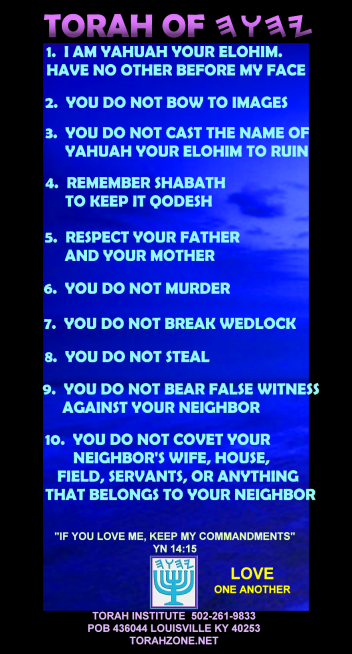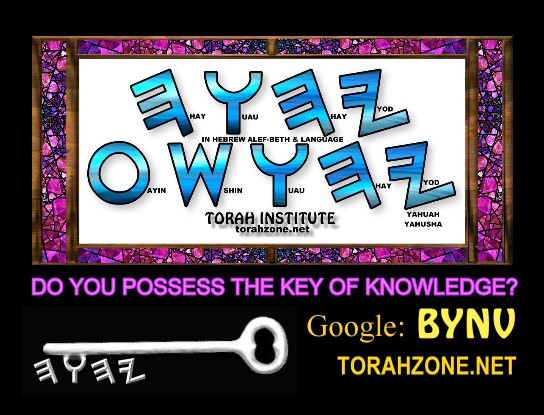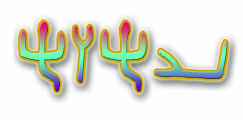
PROTO-SINAITIC SCRIPT: HYKSOS
As teachers, we are to pursue accuracy, and at the same time promote unity
without being "Nicolaitane" as if we are the repository of all knowledge and
power. We simply follow the One Who is that repository, and He is kind and
loving, and seeks, finds, and delivers us, mostly from snares and false
teachings out of His great love for us. When we don't reflect His love toward
others, we grieve His Spirit.
How we write and pronounce letters becomes the primary focus of
some, and this can easily become a snare in itself if it overshadows the
message. A stronghold can form around a teacher and become the
defining aspect that is promoted, consuming all their time and effort. There are
so many things a teacher can “attack”, but if we strain out all the gnats by
looking at the fine details, we may swallow a camel by overlooking the BIG
picture, teaching the message of love.
Yahuah informed us we would be speaking in a foreign tongue, and
our lips would be babbling as we sorted out the message:
Isa 28:9-12:
“Whom would He teach knowledge? And whom would He make to understand the
message? Those weaned from milk, those taken from the breasts! For it is:
command upon command, command upon command, line upon line, line upon line, here
a little, there a little.
For with a
jabbering lip
and a
foreign tongue
He speaks to this people, to whom He said, ‘This is the rest, give rest to the
weary,’ and, ‘This is the refreshing.’ But they would not hear.”
(That is, they would hear in another language, yet not obey the
instructions, the Commandments).
In
a recent article, the main emphasis pointed out the original Hebrew being
the "correct", not just the "most correct". This was obviously in
the minds of those who
transcribed
the "old" Hebrew (aka palaeo-Hebrew) into the Aramaic letters pictured here,
since the prophet's hand-writing of the Name was unaltered in the text:
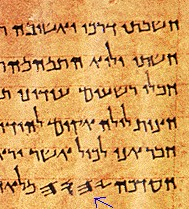
PHOTO SHOWING ORIGINAL NAME AMONG “MODERN” HEBREW – NOTE ARROW
– on Great Isaiah Scroll in the Hekel Sefer (Shrine of the
Book) Yerushalayim, Yisrael
There are going to be many who use alternate Greek and Latin
letters to mimic the original Hebrew, and there will always be alternate ways of
"phonetically" writing letter combinations reflecting the sound of
the Hebrew words. The rendering
"YISRAEL"
may convey the intelligible sound, although the letter "i" being present is a
"phonetic". "YaSHaRaL" could be the sound as well, and I actually prefer it,
since it stands on the Hebrew letters as written, with little need for further
"phonetic" assistance with the adding of the letter "i". The small “a’s”
inserted are unproven “vowels”, but even if incorrect the hearer would be
capable of understanding the meaning in spite of a severe accent. There is
no definitive way of
PROVING
either as being superior however, which is why I embrace an approach that
accepts others' preferences, because otherwise there are
divisions, striving, and competition. I also prefer "AL", "ALAH", and
"ALAHIM". But, I cannot prove "EL" is incorrect, so I accept both
until Yahusha appears to point out the way He wants us to speak, when the
pure lip is restored (Zeph 3:9).
It will certainly not involve English, Greek, or Latin.
Remember, the one that is divisive does not have the Spirit of Yahusha (Yahudah
1:19).
There is a mistake being promoted in some teaching videos that I should point
out, and this is not to tear-down our brothers, but only to make it clear that
we cannot insert ideas we may have into what is taught. It has been
stated that “YASHARAL” contains
4 roots;
YASH, YASHAR, SHAR, & SHARAH. This is how distortion begins. Over-lapping
“roots” in Hebrew words sends mixed, even corrupted meanings into the world.
Hebrew "roots" are made up of two and sometimes three letters. For example, the
Name "YaHUaH" contains the root "HaYaH" in the first part, "YAHU".
The YHU combination is the component containing this root. The ending "H" stands
apart from the "YHU", and operates much the same as the “H” in other names, such
as “TERAH”, the father of Abram.
It is important we not group the final 3 letters, HUH, to be
“another root”
in the Name. “HUaH”
is a root meaning destruction, ruin, mischief (H1942, H1943).
Another common mistake with new teachers involves what I call “changeling
words”.
MARYA is Aramaic for master, yet some create a changeling word when they add their ideas to it. When a word sounds like "yah", some force-out the real root and insert their new spelling. The Hebrew word for the name of the city known as Jerusalem is IRSHALOM, composed of the two words IR (city, foundation) + SHALOM (peace, completeness); thus we have the meaning of "city of peace". When we see it spelled "Yahrushalom", it is inserting another meaning, although with a noble intent. The word begins with yod-resh, not yod-hay, so it is a changeling word. This is done in many words by new teachers with shallow training.
Another example of this is the word MARYA being spelled “MARYAH”, as if the Name “Yah” is a component of it. This is how we can be misled; so word roots need to be left as they are without embellishments added to them.
LANGUAGE IS AN INVENTION, AND A CONVENTION
I have not expressed my opinions on the new so-called “original script”
everyone is seeing all over the Internet, but I simply leave it alone because I
believe what Yahuah said, that He would speak to this people in stammering
lips and a foreign tongue. The script we are seeing
depicting the pictographic hand, man with arms raised, and the tent peg for the
Name is not a threat to anyone, but I want to take this opportunity to explain
it in the kindest way I know how.

PROTO-SINAITIC SCRIPT
It is my belief that “writing” came into existence as an invention before
the flood, which is why we have the writings of Hanoch (Enoch, or Kanok) today. Writing,
like musical notation or even the keyboard I’m using to express my thoughts
here, is not the goal of the invention in itself, but the goal is to share
ideas clearly. Since the Flood (circa 1656 AM), the oldest writings
on Earth found by archaeologists include Sanskrit, Hieroglyphic, Chinese, and
Hebrew – Chinese also includes a pictographic form of writing. The Natsarim
teachers in China use their ancient script to teach the message to their
population, showing how the compound symbols in their letters are expressions of
the Truth from ancient times. Yahuah confused our languages for a purpose, so we
have to recognize what He has “bent” cannot be “straightened” (Eccl 7:13).
The prophets wrote in the script you and I promote, as you can see in the
attachment the copies made of their writings into “modern” Hebrew (Aramaic)
depict the Name in the form the prophets used. What is being promoted as “older”
Hebrew, even the “oldest” Hebrew, is based on letter shapes derived from
hieroglyphics (logograms, where symbols stood for entire words). The first use
of these letters shapes were not used by the prophets, as you are about to find
out.
WHEN CANAANITES RULED EGYPT
In the central Sinai peninsula, a rugged, arid area, Egyptians in the 19th
century BCE mined
turquoise
from caves there. There is a site now called Serabit el-Khedem,
the site of an ancient settlement where this mining operation was conducted over
an approximate 800-year span of time. Expeditions from Egypt were made to
oversee the extraction of the highly-valued
turquoise stone,
and Canaanite
“Hyksos”
were put to work as part of the workforce.
HYKSOS:
Asiatic (Shemitic) people that migrated from the north toward Egypt around 1900
BCE and onward, making up what we call “Canaanites”, and conquered the land of
Egypt just before the time of Yosef (son of Yisrael / Ya’aqob). A distinctive
characteristic of these people was their “mushroom” hairdo. The pharaoh in the
day of Yosef was most likely of Hyksos derivation.
I thought you’d like the mushroom-hairdo feature:
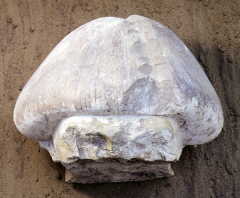
The Hyksos were illiterate, but quite fascinated by the hieroglyphs, and
attempted to leave their impressions of these “logograms” inside the caves.
Some believe they were leaving such symbols as expressions of prayers to the
Egyptian deity “HATHOR” to protect them, however their symbols were very crude
compared to the sophisticated hieroglyphs they were seeing at a nearby TEMPLE
dedicated to the deity.
Serabit’s Hathor temple
was at this mining site and maintained for some 800 years. Why Hathor? She was
the Egyptian deity of turquoise, referred to in the hieroglyphs as the
“Mistress of Turquoise”.
Pictures of this site:
https://www.google.com/search?q=hathor+temple+at+serabit+picture&hl=en&tbo=u&rlz=1C1SKPL_enUS432&tbm=isch&source=univ&sa=X&ei=pMnAUOarBIa50QHB0ICgBg&ved=0CDEQsAQ&biw=1280&bih=598
The so-called “ancient script” (not used by any prophet as far as can be
determined), originated from the scribbling on cave walls by the Hyksos/Canaanites,
but this in no way should be cause for anyone to rally against those who promote
it now. It’s more accurate to understand the script as “Mitsrayim/Hyksos”,
although archaeologists refer to the script as “proto-Sinaitic”. Whatever we may
use for it, it’s a form of writing ideas.
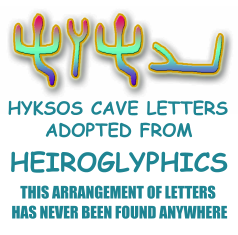 The Hyksos didn't serve Yahuah, and so never wrote
His Name, as far as we've been able to determine.
The Hyksos didn't serve Yahuah, and so never wrote
His Name, as far as we've been able to determine.
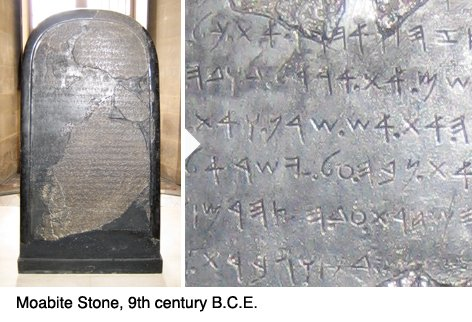 Tel Dan Stela:
Tel Dan Stela: 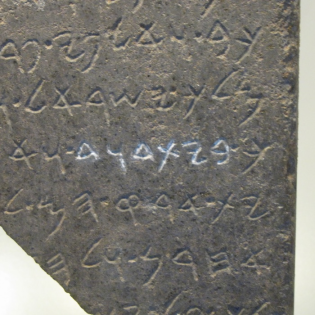

The Hyksos didn't serve Yahuah, and so never wrote His Name, as far as we've been able to determine.
The Moabite Stone and the Tel Dan Stela both utilize the ancient alphabet, and here's what the script looks like:
 Tel Dan Stela:
Tel Dan Stela:


On the Tel Dan Stela, the six letters emphasized in white are beth-yod-tau (BETH, house) and daleth-uau-daleth (the name, Da’ud), and means “house of Da’ud”.
It is the first physical evidence discovered from archaeology of Da’ud’s existence, and dates to the 9th century BCE. What is very interesting is the way the inscription depicts the letter “uau”; in our modern “type” it appears as we would print the letter u, only with the right side dropping down. The Greek inherited the letter from the Hebrew, making it “Y”, the “upsilon”, also equivalent to our letter “u”. The Moabite Stone, left above, contains the Name of Yahuah, and was a monument (stela) written by heathens that used the very same script the prophets wrote in! Obviously, the heathen’s literacy was inherited from the Hebrews, not the other way around. Here is a close-up view of the Name as it actually appears on the dark Moabite Stone:
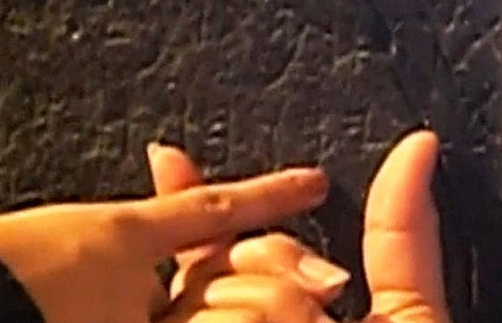
The Los Lunas Stone discovered in New Mexico (USA) is another ancient artifact
that uses the “ancient Hebrew” as the prophets wrote in. There are literally
hundreds of items discovered all over the land of Yisrael that have the
four-lettered Name (Tetragrammaton) written in the form above, yet not one that
uses the Hyksos Proto-Siniatic script to express His Name.
When in doubt, always appeal to actual physical evidence, and don't rely solely on a letter chart to support a hypothesis.
The study of language and writing
is “deep waters”, and when those waters form a “whirlpool” we can easily be
drawn away into them, and Yahusha’s work interrupted or harmed. This is a very
serious problem among many teachers today, but Yahuah is using some of us to be
guardians against the “strongholds” which so easily ensnare teachers and those
trying to learn. Yes, we are all babbling to a great extent, but we are called
to love those that Yahusha has redeemed, even in their babbling. Yahusha has
redeemed a large number of babblers, and I’m so thankful to be one of them! He
who exalts himself will be humbled, and he who humbles himself will be exalted -
always put others first. We ought not think of ourselves more highly than
we should, we are all members of one another
(Romans 12 – if you read this chapter at least once a week, it will keep you on
the right track).
Love means never having to make someone feel inferior. Serve others, and thereby you are loving them.
More details on this subject can be investigated here:
http://www.fossilizedcustoms.com/hyksoshoax.html
brother Lew
(Lew White)
Torah Institute
http://www.torahzone.net
Aseret
ha’Dabarim (Ten Words)
TORAH INSTITUTE
phone: 502-261-9833
google: BYNV
